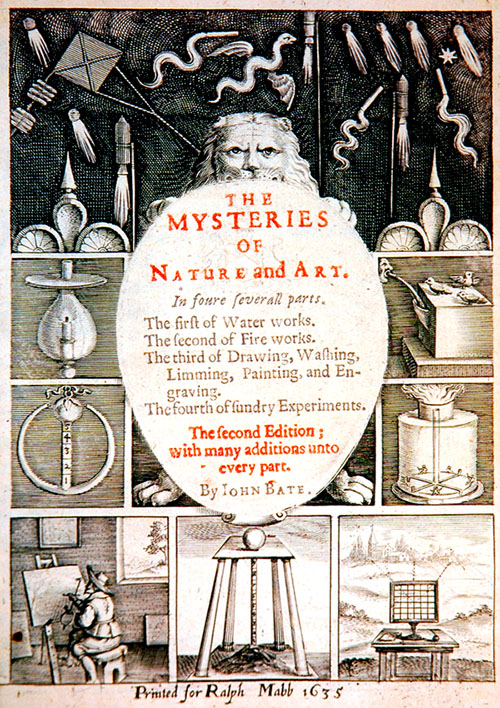The Mysteries of Nature and Art
Today, John Bate's wonderful book. The University of Houston's College of Engineering presents this series about the machines that make our civilization run, and the people whose ingenuity created them.
We know little of the life of John Bate -- only that he left us a remarkable book. It was not terribly original -- he mostly copied from earlier authors. But he was enormously influential, if only for one reader: a teenage boy named Isaac Newton. Newton was at a small private school where he boarded with an apothecary.
There he found a copy of Bate's book, > That was an alchemical-sounding title and Newton was famously interested in alchemy. The book is broken into sections on waterworks, fireworks, drawing, and chemistry -- halfway mirroring the alchemical elements. But despite all that, something beyond alchemy went on between Newton and this book.
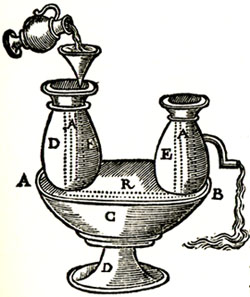 Take Bate's "Water-workes" -- a fine collection of hydraulic devices: pumps, water clocks, early thermometers -- also tricky self-refilling bowls. We find experiments that demonstrate hydraulic pressure and properties of gases. It starts out looking like alchemy and quickly turns into solid engineering. Newton spent his limited pennies on a sheaf of paper, and began copying the book out in tiny letters. He also built one of Bate's water clocks.
Take Bate's "Water-workes" -- a fine collection of hydraulic devices: pumps, water clocks, early thermometers -- also tricky self-refilling bowls. We find experiments that demonstrate hydraulic pressure and properties of gases. It starts out looking like alchemy and quickly turns into solid engineering. Newton spent his limited pennies on a sheaf of paper, and began copying the book out in tiny letters. He also built one of Bate's water clocks.
The section on fireworks is very much like those boys' books of the early 20th-century -- the ones responsible for so many lost eyes and fingers. Rockets, pipe bombs, torpedoes. Such fun! After reading Bate, Newton sent a black kite aloft at night carrying a small lantern. He meant to terrify his neighbors with it.

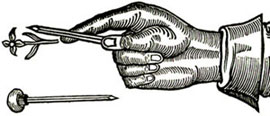 Newton paid special attention to the section on drawing, with all its information about color. He remained fascinated by -- even obsessed with -- color, throughout his life.
Newton paid special attention to the section on drawing, with all its information about color. He remained fascinated by -- even obsessed with -- color, throughout his life.
Bate's last section gives us the practical face of alchemy. He titled it Extravagants, but it was all about chemistry -- both practical and flamboyant. We learn how to make ice that'll melt in fire, but won't dissolve in water. We learn to make marbled paper, to cement glass, to plate iron with gold, to sir up an ointment for burns or a plaster for backaches.
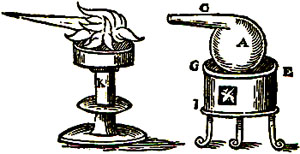 So out of this mish-mash of manual arts, techniques, and lingering patina of renaissance alchemy, emerged Newton with all his brilliance and contradiction. He was the model of the new experimental scientist, and a caricature of yesterday's magical alchemy. Of course, other influences shaped this frustratingly complex, sometimes petty, man. But here in Bate's book we see all the elements and contradictions of the person Newton would become.
So out of this mish-mash of manual arts, techniques, and lingering patina of renaissance alchemy, emerged Newton with all his brilliance and contradiction. He was the model of the new experimental scientist, and a caricature of yesterday's magical alchemy. Of course, other influences shaped this frustratingly complex, sometimes petty, man. But here in Bate's book we see all the elements and contradictions of the person Newton would become.
I wish we had time to turn pages together. Bate's directions for mixing paints alone would bring OSHA inspectors to our door today -- concoctions of cinnabar, egg yolks, quicksilver, alum, lead, gum Arabic, and brimstone. And that's not the worst of it.
Yet, out of all this came the same Newton Alexander Pope saw, when he wrote, "God said, Let Newton be! and all was light."
I'm John Lienhard at the University of Houston, where we're interested in the way inventive minds work.
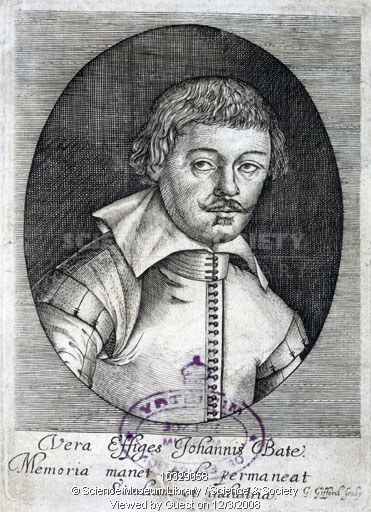 J. Bates, The Mysteries of Nature and Art. (London: Thomas Harper for Ralph Mabb, 1634/1635). All illustrations are from this source. Samples of Bate's book may be seen online here.
J. Bates, The Mysteries of Nature and Art. (London: Thomas Harper for Ralph Mabb, 1634/1635). All illustrations are from this source. Samples of Bate's book may be seen online here.
J. Gleick, Isaac Newton. (New York: Pantheon, 2003): Chapter 1.
Many of Bate's hydraulic devices are taken from works of the ancient Hellenistic engineers. See, for example, Episode 1942.
Right/Above: Image of John Bate on the book's frontispiece.
Below: Title page of Bate's The Mysteries of Nature and Art.
